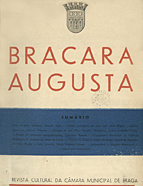

................................
The latest issue of Bracara Augusta is now number 132, with two issues currently in press. With a monthly, quarterly, half-yearly and annual publication schedule, it maintains a sober layout with few graphic changes throughout its editorial existence, adorned with engravings and photographs to illustrate academic news. With a variable price over the last few decades, it can currently be purchased at a unit price of 15 euros, with the option of taking out a subscription. Meanwhile, the third series consists of the Revista Cultural Bracara Augusta , under the direction of Luís Alexandre Cabral da Silva Pereira (1947-), not forgetting the special editions dedicated to the “Tribute to Dr. Sérgio da Silva Pinto” and the Sanctuary of Bom Jesus de Braga, among other historical events and celebrities, such as the famous archbishop of Braga, D. Fr. Bartolomeu dos Mártires (1514-1590) or Fr. António do Rosado (c. 1575-1640), for example.
The vast content of Bracara Augusta covers all historical periods from Prehistory to Classical Antiquity and, of course, Roman imperial historiography, alluding to the ancient traditions of Romanisation in Portuguese territory. In fact, the immense importance of archaeological research and the promotion of archaeology itself since the early days of this publication, which contains the most distinguished observations on Portuguese Castreja culture, stands out. As a scholarly publication focused primarily on the dissemination of academic work, always guided by scientific rigour, most of the contributors have dealt with topics related to local and regional history around Braga and northern Portugal, appearing regularly in specialised bibliographical references.
Mainly covering cultural topics in their entirety, Bracara Augusta features a wide range of genealogical and patronymic studies, focusing on the early days of the Church, following its establishment in the consolidation of the national territory and later in overseas territories. However, its wealth is far from exhausted in these fields, as can be seen in the fruitful works dedicated to medieval arts, crafts and techniques, as well as the interpretation of national architectural trends, particularly in the evolution of our rural and urban planning.
This work is financed by national funds through FCT - Foundation for Science and Technology, I.P, in the scope of the projects UIDB/04311/2020 and UIDP/04311/2020.
